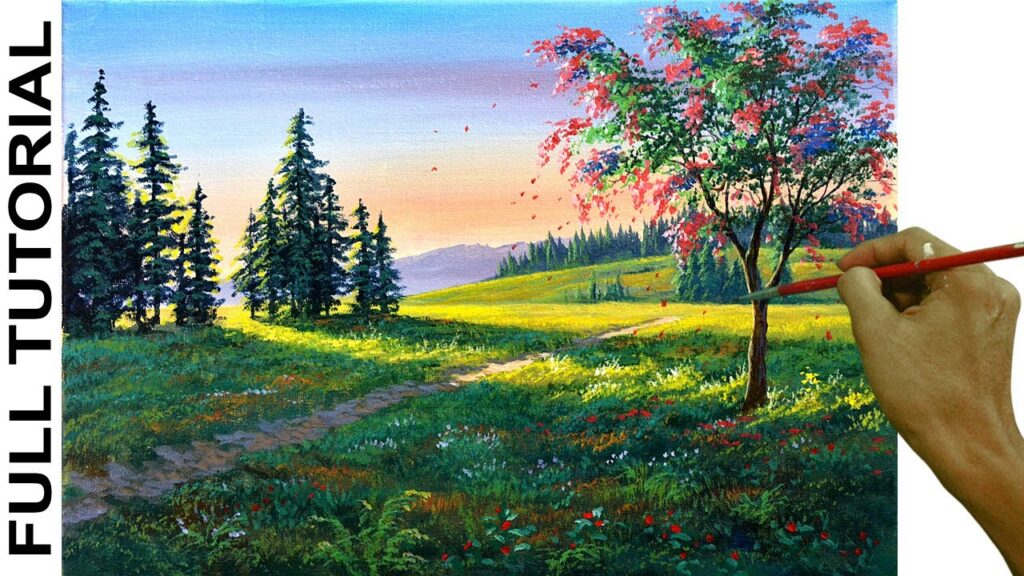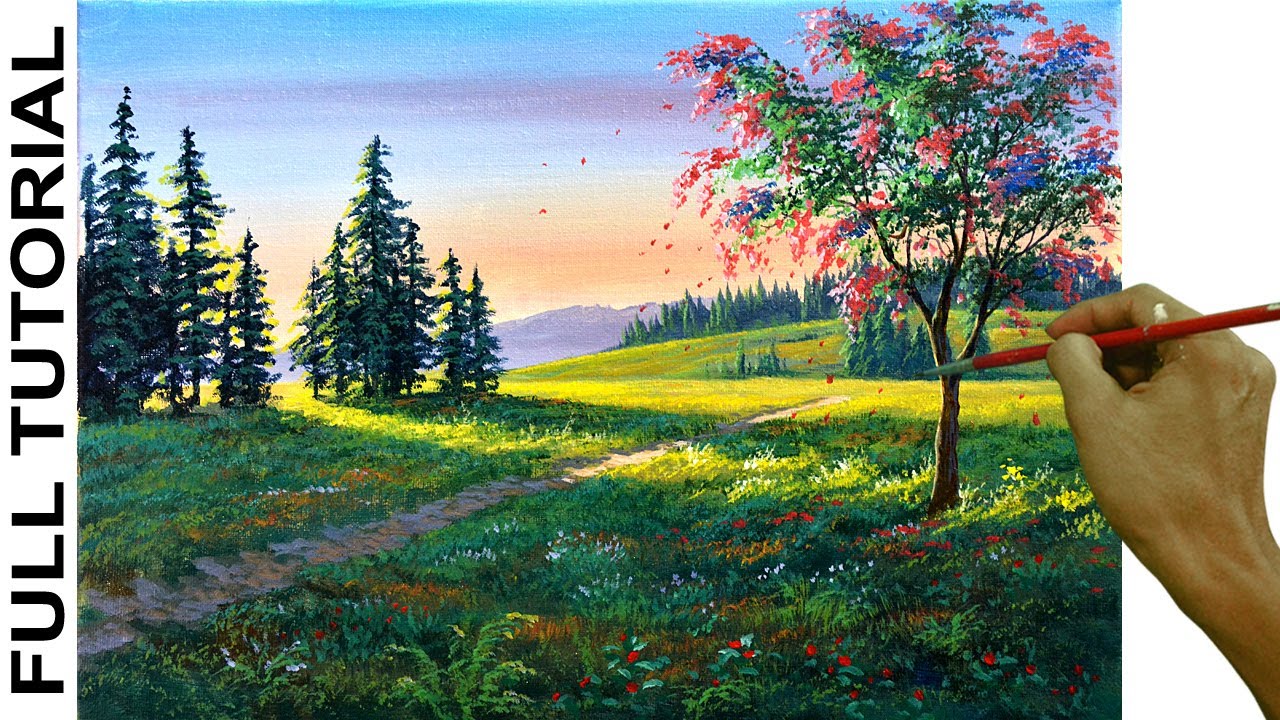
Unlocking the Beauty of Nature: A Comprehensive Guide to Acrylic Landscape Painting
Acrylic landscape painting offers a vibrant and accessible medium for artists of all skill levels to capture the beauty of the natural world. From serene sunsets to majestic mountains, the versatility of acrylics allows for a wide range of artistic expression. This comprehensive guide will delve into the techniques, materials, and inspiration behind creating stunning acrylic landscape paintings. Whether you’re a beginner picking up a brush for the first time or an experienced artist looking to refine your skills, this article provides valuable insights into the world of acrylic landscape painting.
Why Choose Acrylics for Landscape Painting?
Acrylic paints have become a popular choice for landscape artists due to several key advantages:
- Fast Drying Time: Acrylics dry quickly, allowing for layering and quick adjustments. This is especially beneficial for plein air painting, where changing light conditions demand a faster pace.
- Versatility: They can be used on a variety of surfaces, including canvas, wood, and paper. Acrylics can be thinned with water to mimic watercolors or used straight from the tube for bold, impasto effects.
- Durability: Once dry, acrylics are water-resistant and permanent, ensuring your artwork will last for years to come.
- Vibrant Colors: Acrylics offer a wide range of intense and vibrant colors, allowing you to accurately depict the hues of nature.
- Easy to Clean: Clean up is easy with soap and water, making acrylics a convenient medium for artists of all ages.
Essential Materials for Acrylic Landscape Painting
Before you begin your acrylic landscape painting journey, gather the following essential materials:
- Acrylic Paints: A basic set of acrylic paints including primary colors (red, blue, yellow), white, and black is a good starting point. Expand your palette as you gain experience. Consider including earth tones like burnt umber, raw sienna, and yellow ochre, which are essential for landscape painting.
- Brushes: Invest in a variety of brushes in different shapes and sizes. Flat brushes are great for covering large areas, while round brushes are ideal for detail work. Filbert brushes offer a versatile option for blending and creating soft edges.
- Canvas or Painting Surface: Stretched canvas is a popular choice for acrylic painting, but you can also use canvas panels, wood panels, or even heavy-duty paper.
- Palette: A palette is used to hold and mix your paints. Disposable paper palettes are convenient, while reusable plastic palettes can be easily cleaned. A stay-wet palette can help keep your acrylics from drying out too quickly.
- Water Container: Keep a container of clean water nearby for rinsing your brushes.
- Palette Knife or Painting Knife: These tools can be used to apply paint in thick, textured layers.
- Easel (Optional): An easel can provide a comfortable and stable surface for painting.
- Mediums (Optional): Acrylic mediums can be used to alter the properties of your paints, such as drying time, viscosity, and gloss level.
Techniques for Creating Stunning Acrylic Landscapes
Mastering a few key techniques will help you create realistic and expressive acrylic landscape paintings:
Understanding Perspective
Perspective is crucial for creating a sense of depth and realism in your landscape paintings. Linear perspective involves using vanishing points on the horizon line to create the illusion of distance. Atmospheric perspective uses changes in color and value to suggest depth; objects in the distance appear lighter and less saturated.
Color Mixing and Value
Understanding color theory and value (the lightness or darkness of a color) is essential for creating realistic landscapes. Practice mixing colors to achieve the desired hues. Pay attention to the values in your reference photo and try to replicate them in your painting. Using a limited palette can help you create harmonious color schemes.
Layering and Blending
Acrylics are well-suited for layering, allowing you to build up depth and complexity in your paintings. Start with thin washes of color and gradually add thicker layers. Blending is key to creating smooth transitions between colors. Use a soft brush or a palette knife to blend the edges of your paint strokes.
Creating Texture
Adding texture can bring your landscapes to life. Use a palette knife to apply thick layers of paint for an impasto effect. You can also use various tools and techniques to create interesting textures, such as dry brushing, stippling, and scumbling.
Painting Skies and Clouds
The sky is a crucial element in many landscape paintings. Pay attention to the colors and shapes of the clouds. Use soft, blended brushstrokes to create a sense of atmosphere. Consider the time of day and the weather conditions when painting the sky.
Depicting Trees and Foliage
Trees and foliage can be challenging to paint, but with practice, you can learn to capture their intricate details. Start by blocking in the basic shapes of the trees. Then, add details such as branches, leaves, and shadows. Vary your brushstrokes to create a more natural and organic look.
Rendering Water
Painting water requires careful attention to reflections and movement. Use horizontal brushstrokes to create the illusion of a smooth surface. Add highlights and shadows to depict the ripples and waves. Consider the colors of the surrounding landscape when painting reflections.
Finding Inspiration for Your Acrylic Landscape Paintings
Inspiration for acrylic landscape painting can be found everywhere around you:
- Nature: Spend time outdoors observing the natural world. Take photos, sketch, and make notes of the colors, shapes, and textures that inspire you.
- Photography: Use photographs as reference material for your paintings. Pay attention to the composition, lighting, and colors in the photos.
- Other Artists: Study the work of other landscape painters. Analyze their techniques and try to incorporate them into your own paintings. [See also: Famous Landscape Artists and Their Techniques]
- Travel: Explore different landscapes and cultures. Each new place offers unique opportunities for artistic expression.
- Imagination: Don’t be afraid to create landscapes from your imagination. Let your creativity guide you and experiment with different colors and compositions.
Tips for Beginners in Acrylic Landscape Painting
If you’re new to acrylic landscape painting, here are a few tips to help you get started:
- Start Simple: Begin with simple landscapes and gradually work your way up to more complex compositions.
- Practice Regularly: The more you paint, the better you’ll become. Set aside time each week to practice your skills.
- Don’t Be Afraid to Experiment: Try different techniques and approaches to find what works best for you.
- Learn from Your Mistakes: Don’t get discouraged by mistakes. Use them as learning opportunities.
- Take a Class or Workshop: Consider taking a class or workshop to learn from experienced artists.
Advanced Techniques in Acrylic Landscape Painting
For experienced artists looking to push their boundaries, consider exploring these advanced techniques:
Glazing
Glazing involves applying thin, transparent layers of paint over dried layers. This technique can be used to create subtle color variations and luminous effects.
Scumbling
Scumbling is a technique where you apply a broken layer of paint over a dry surface. This can create a textured, atmospheric effect.
Dry Brushing
Dry brushing involves using a dry brush with a small amount of paint to create a textured effect. This is particularly useful for depicting foliage and rough surfaces.
Underpainting
Creating an underpainting in a complementary color can add depth and vibrancy to your finished painting. [See also: The Power of Underpainting in Acrylic Art]
Preserving and Displaying Your Acrylic Landscape Paintings
Once you’ve finished your acrylic landscape painting, it’s important to preserve and display it properly:
- Varnishing: Varnishing protects your painting from dust, dirt, and UV damage. Choose a varnish specifically designed for acrylics.
- Framing: Framing your painting can enhance its appearance and protect it from damage. Choose a frame that complements the style of your painting.
- Storage: Store your paintings in a cool, dry place away from direct sunlight.
Conclusion: Embracing the Journey of Acrylic Landscape Painting
Acrylic landscape painting is a rewarding and fulfilling artistic pursuit. By understanding the techniques, materials, and inspiration behind it, you can create stunning works of art that capture the beauty of the natural world. Whether you’re a beginner or an experienced artist, there’s always something new to learn and explore. Embrace the journey, experiment with different approaches, and let your creativity flourish. The world of acrylic landscape painting awaits, offering endless possibilities for artistic expression. Remember to practice regularly, find inspiration in the world around you, and most importantly, enjoy the process of creating your own unique acrylic landscape paintings. This guide provides a solid foundation for your artistic journey, but the true magic lies in your own interpretation and expression. So, pick up your brushes, embrace the colors, and let your acrylic landscape painting adventure begin!

